IITA, MAAIF, NARO, and ASARECA Join Forces to Sensitize Farmers on Combatting BBTV
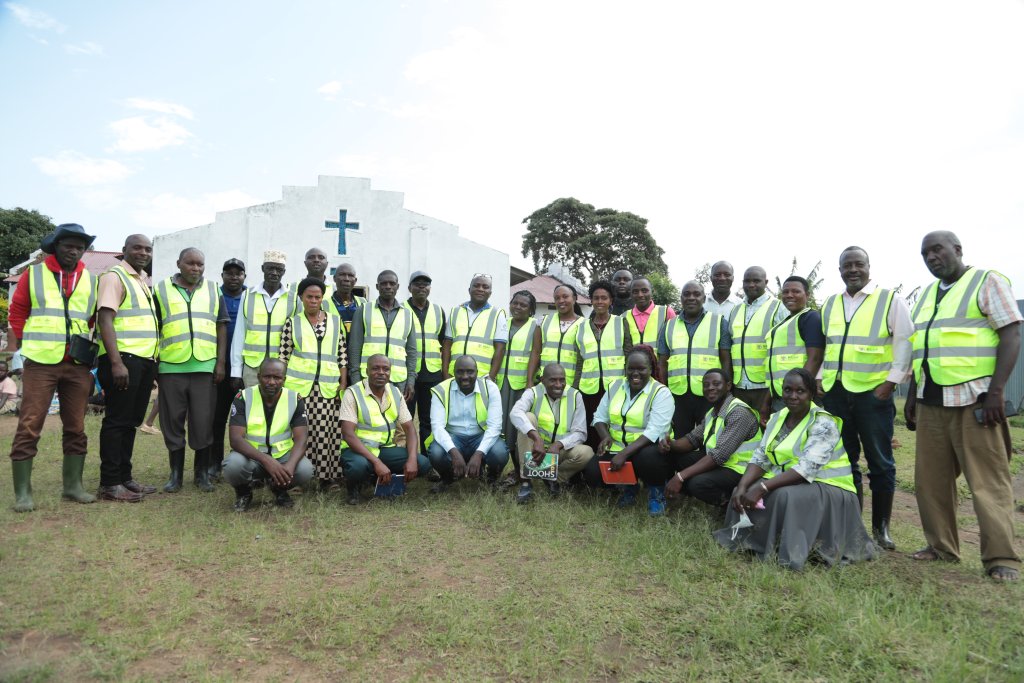
Farmers from virus-free Districts of Bushenyi, Rubirizi, and Bunyangabu pose for a group photo with experts
By Genevieve Apio
Kasese District, Uganda – A pivotal two-day farmers’ study tour focusing on tackling the Banana Bunchy Top Virus (BBTV) was held in Kasese District, Uganda. The tour, organized by the Ukama Ustawi (UU) Learning Alliance, a CGIAR-led initiative supported by the United States Department of Agriculture’s Foreign Agricultural Services (USDA-FAS) and the Plant Health Initiative, aimed to combat the growing threat that BBTV poses to banana production in Uganda.
The farmer-to-farmer learning visit, conducted from October 3 to 4, 2024, brought together smallholder farmers, researchers, and agricultural extension officers from virus-free Districts of Bushenyi, Rubirizi, and Bunyangabu to learn from farmers in the virus-stricken district of Kasese. These districts are at high risk from BBTV due to their proximity to Kasese district which is already affected by BBTV. The event aimed to raise awareness among farmers on the dangers posed by the disease with knowledge and adequately prepare them to fight against the disease by facilitating peer-to-peer skills to protect their counterparts in Kasese District, where the disease is already prevalent.
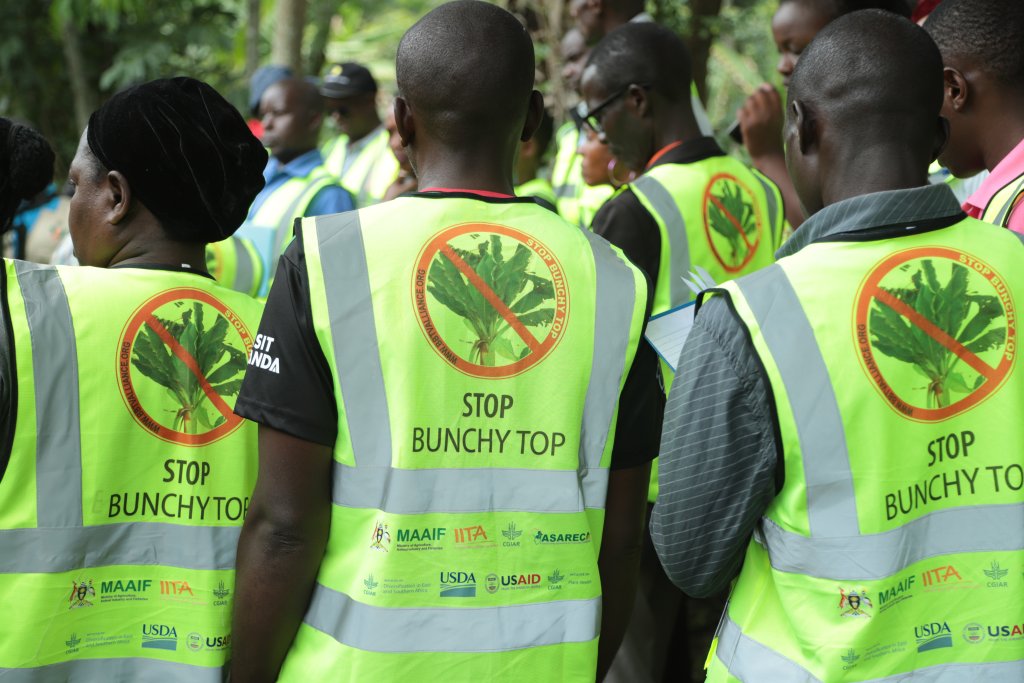
Farmers learning from another farmer affected by the BBTV in the field
This event marks a significant step towards protecting Uganda’s bananas from the virus, which is threatening food security and livelihoods of millions of smallholder farmers. The Ministry of Agriculture first raised concerns about the BBTV in 2020 after it caused significant yield losses in bananas in West Nile and Kasese all bordering the Democratic Republic of Congo. The disease has now spread across five sub-counties of Kasese District, following its introduction from the neighboring Democratic Republic of Congo.
The BBTV has now become a critical agricultural and food security concern in Uganda. The disease causes stunted growth in banana plants, leading to severe yield losses.The estimated production losses due to BBTV in Uganda varied based on the severity of the infestation. On average, BBTV led to yield losses of up to 90% in heavily infested areas. In regions such as Kasese, where the virus spread extensively, entire plantations were abandoned, causing substantial economic losses. It was reported that the virus affected up to 38% of banana plantations in Kasese and other parts of Uganda; and across Africa estimated to be between $200 million and $600 million annually.
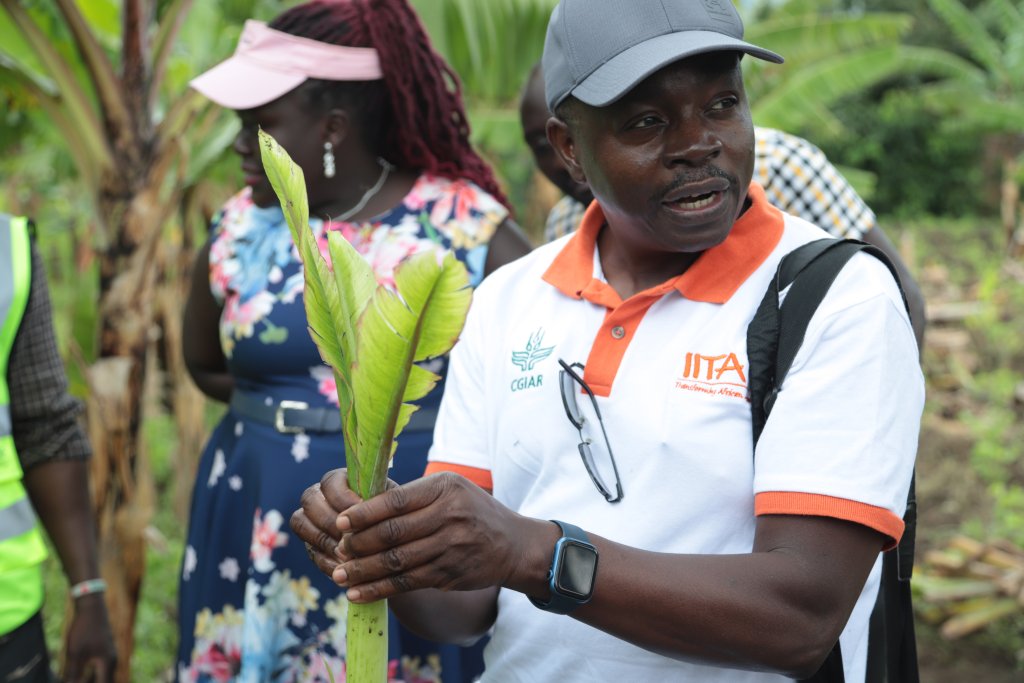
Dr. George Mahuku, Plant Pathologist and Project Lead (IITA) giving a practical and technical view of BBTV to farmers
Dr. George Mahuku, Plant Pathologist and Project Lead at the International Institute of Tropical Agriculture (IITA), emphasized the importance of a regional approach to combating BBTV, stating that “Diseases like BBTV do not respect borders. Our borders are porous, and people often carry planting material with them, inadvertently introducing the virus into new areas.”
A Collaborative Effort Against BBTV
Ms. Blaise Amony, Program Officer for Partnerships and Capacity Development at the Association for Strengthening Agricultural Research in Eastern and Central Africa (ASARECA) highlighted the importance of addressing the spread of BBTV to safeguard banana production in Eastern and Central Africa. She said that about 5 countries had already been affected in the ASARECA member states (Uganda, Kenya, Tanzania, Burundi, and the Democratic Republic of Congo).
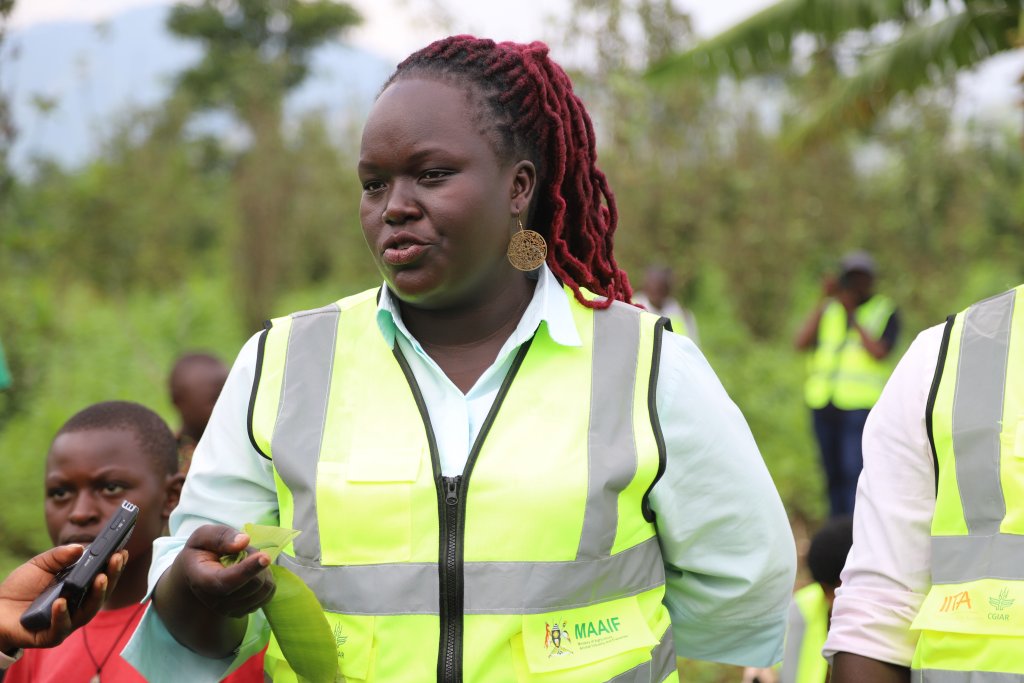
Ms. Blaise Amony, Program Officer for Partnerships and Capacity Development (ASARECA) addressing farmers in the field.
“Managing the spread of BBTV is critical to protecting banana production in the region. ASARECA plays a key role in combating the virus through a combination of strategies involving research, collaboration, and practical interventions at the field level. By working with National Agricultural Research Systems (NARS) and international partners, we can develop and promote disease-resistant banana varieties, as well as conduct field trials to assess their performance across various agroecological zones. These efforts will provide farmers with more resilient planting materials to reduce the impact of the virus,” Amony said.
The study tour’s main goal was to educate farmers from non-affected regions on the preventive measures necessary to stop the virus from spreading. Farmers observed firsthand how BBTV affects banana plants and learned best practices for disease control, including using certified disease-free planting materials.
Testimonies from the Field
Mr. Bwambale Anatosi, a farmer from Kasese District, shared his experience dealing with BBTV in his 8-acre banana plantation, which ultimately forced him to abandon banana farming. Bwambale was the first farmer to detect the disease in 2021 on his plantation and reported to the District agricultural officer when he noticed a stunted growth of the banana plants.
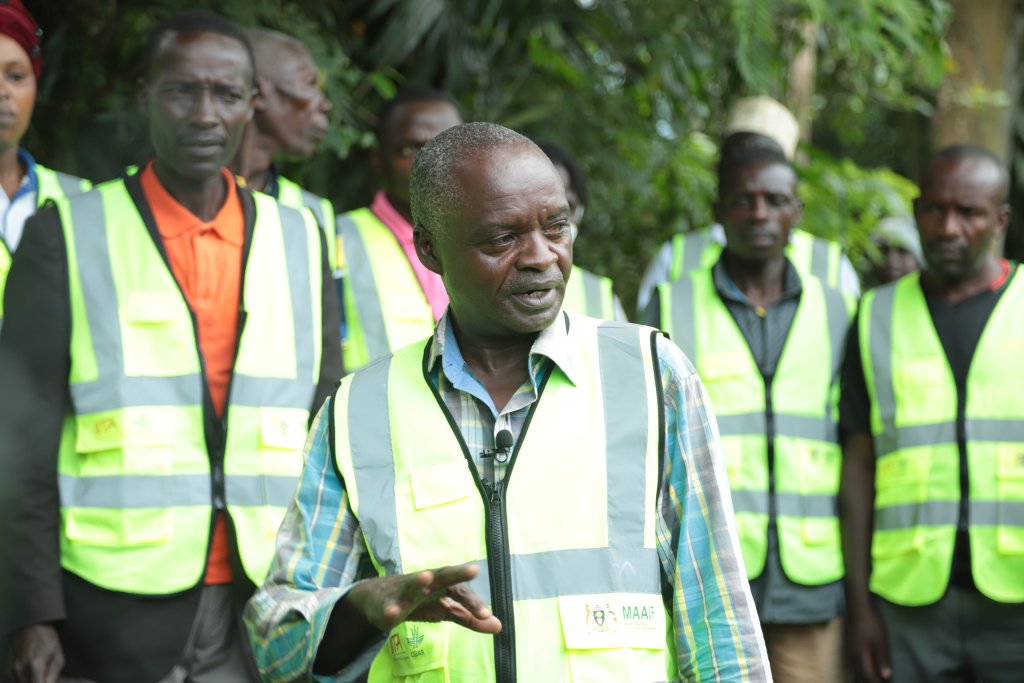
Mr. Bwambale Anatosi, a farmer from Kasese District affected by BBTV
“I tried everything—clearing infected plants, sanitizing the farm, and following management practices. Yet, the plants remained stunted,” he said, recounting the challenges of managing the disease before switching to cocoa farming.
Experts Stress Prevention and Awareness
Dr. Julius Rukara, the District Agricultural Officer in Kasese, highlighted the project’s role in disease surveillance and farmer sensitization. “The project has greatly helped in tracking the disease and raising awareness across the district. We have used a variety of methods, including local radios and extension staff, to inform farmers in affected areas,” he said.
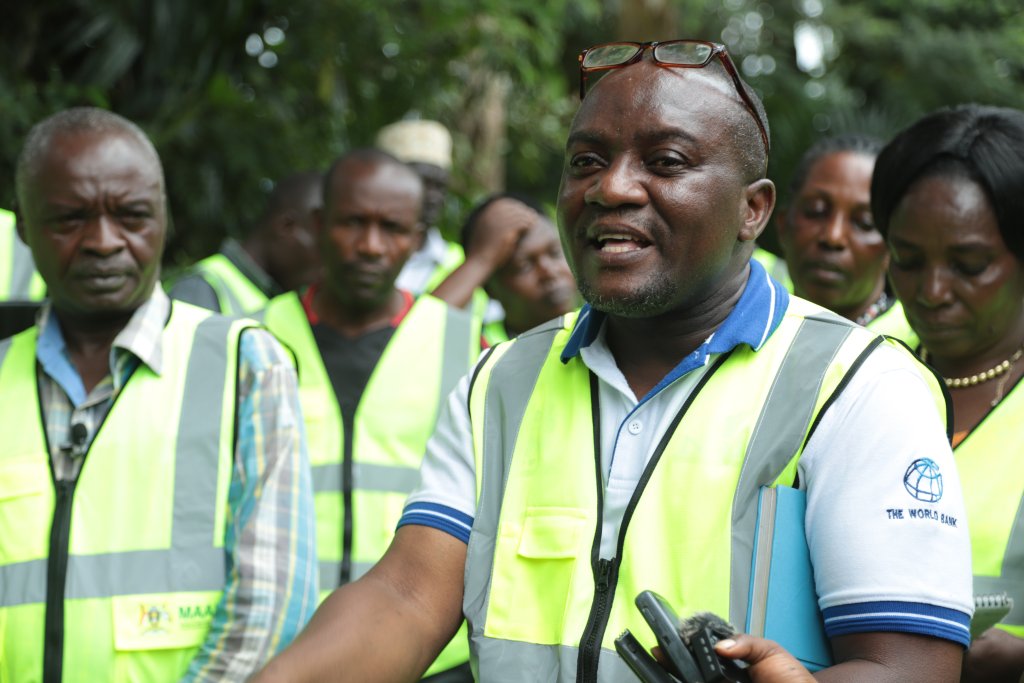
Dr. Julius Rukara, the District Agricultural Officer in Kasese
Dr. Alex Barakye, Head of the Banana Research Program at NARO said, “It is crucial for farmers to adopt effective management practices to control the spread of BBTV, as the virus can devastate banana production if left unchecked. Practices such as regular monitoring of banana plants, early detection of infected plants, proper disposal of infected material, and controlling the population of the banana aphid (the virus vector) are vital. Implementing these measures helps maintain healthy crops and reduces the economic losses associated with BBTV outbreaks.”
Spread and Control of Banana Bunchy Top Virus (BBTV) Symptoms of bananas affected by BBTV
How the BBTV spreads
- sourced from infected plants
The BBTV spreads through majorly through use of diseased plant material. The infected plants are usually stunted and exhibit stunted growth, a hallmark symptom of the virus. The virus causes leaves to bunch together, giving the plant a distinctive “bunchy top” appearance. The infected plants also show yellowing at the leaf edges due to impaired nutrient uptake and ultimately fail to produce banana bunches, leading to severe crop loss.
The Ugandan government, in collaboration with agricultural organizations, has implemented a series of measures to curb the spread of BBTV. These have largely included plant quarantine, restriction of moving planting materials from affected areas and raising awareness on the impacts of the disease on banana production aphid control. Aphids are found in all areas where banana is produced. On their own, they have no impact on the banana plant. It is only when they feed on BBTV infected plants that they become a significant factor in the disease cycle. Extension services have been instrumental in educating farmers on the importance of early detection and good management practices.
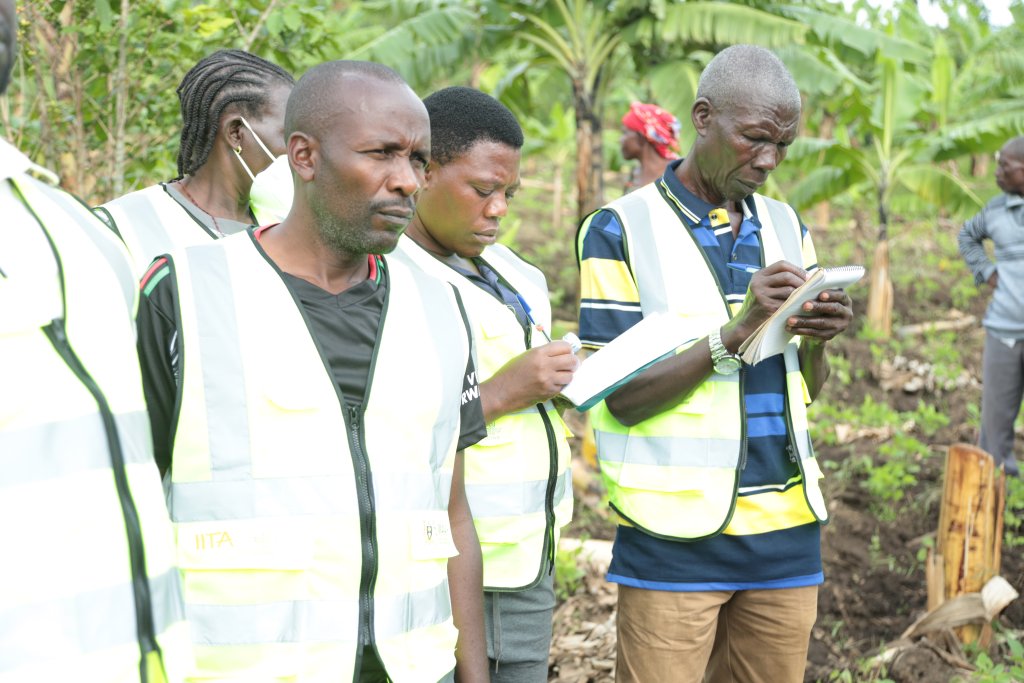
Farmers taking notes as they learn about the spread of BBTV from an affected banana plantation
At the end of the study visit, participants expressed a renewed commitment to safeguarding their districts from BBTV. The knowledge gained from the event will help farmers in virus-free areas take proactive measures to prevent its spread.
Ms. Mary Tumusiime, a farmer from Bushenyi District, remarked, “We now understand the damage BBTV causes and know how to prevent it from reaching our farms.”
Conclusion
With the right combination of research, field interventions, and farmer education, there remains hope that Uganda’s banana industry will overcome the threat of BBTV. The collaborative efforts between local and international stakeholders provide a solid foundation for continued vigilance in combating the virus, ensuring food security and economic stability for banana farmers across the region.
Contributors Dr. George Mahuku (IITA), Mr. Moses Odeke (ASARECA), and Ms. Blaise Amony (ASARECA).
